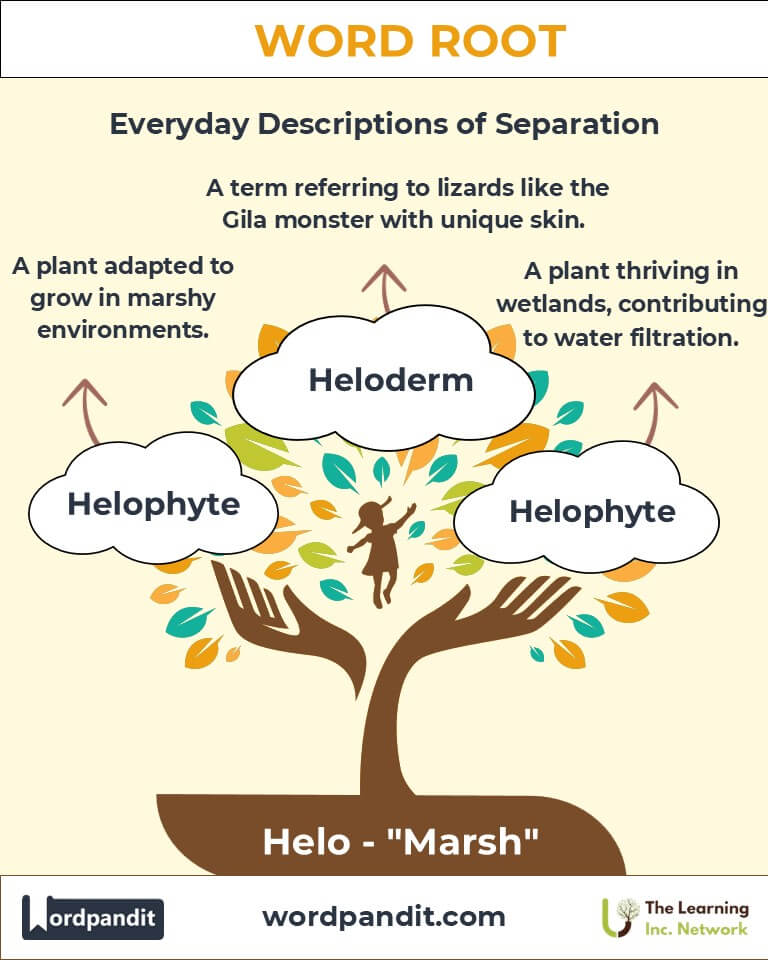Hel: The Marshy Foundation of Language and Nature
Discover the intriguing root "hel," meaning "marsh," and its significance in words like helophyte and heloderm. This root illustrates the unique relationship between language, environment, and specialized fields such as biology and ecology.

Table of Contents
- Introduction: The Essence of Hel
- Etymology and Historical Journey
- Mnemonic: Unlocking the Power of Hel
- Common Hel-Related Terms
- Hel Through Time
- Hel in Specialized Fields
- Illustrative Story: Hel in Action
- Cultural Significance of the Hel Root
- The Hel Family Tree
- Conclusion: The Living Legacy of Hel
Introduction: The Essence of Hel
The root hel (pronounced hel) originates from Greek, meaning marsh or wetland. It is at the heart of words like helophyte (plants that thrive in marshy habitats) and heloderm (marsh-associated animals, such as the venomous Gila monster). The "hel" root provides a linguistic connection to the intricate ecosystems of wetlands and the organisms that call them home.
Etymology and Historical Journey
The root hel derives from the Greek word helos, meaning marsh or swampy ground. Ancient Greek naturalists often used this term to classify plants and animals inhabiting wetlands. Over time, "hel" permeated Latin and then modern scientific terminology, enriching disciplines like ecology and zoology.
Mnemonic: Unlocking the Power of Hel
To remember hel, picture a lush, green marsh teeming with life—plants rising above the water and animals resting on the banks.
Mnemonic Device: "Hel helps life grow in marshes, from plants to creatures."
Common Hel-Related Terms
- Helophyte (hel-o-fite): A plant adapted to grow in marshy or wetland environments.
Example: "Cattails are common helophytes found near ponds." - Heloderm (hel-o-derm): A genus of venomous lizards, including the Gila monster, often associated with marshy regions.
Example: "The heloderm's skin is both armored and vibrant." - Helobious (hel-o-bee-us): Inhabiting or growing in marshes.
Example: "The helobious snails play an important role in the wetland ecosystem." - Helophyton (hel-o-fie-ton): A general term for marsh plants.
Example: "Helophyton species dominate this wetland habitat."
Hel Through Time
The evolution of "hel" showcases its environmental importance:
- Ancient Greek: Used helos to describe marshy terrains and their unique flora and fauna.
- Middle Ages: The term was adopted in botanical texts to classify wetland plants.
- Modern Science: Today, "hel" features prominently in ecological and zoological studies, reflecting its enduring relevance.
Hel in Specialized Fields
- Ecology and Botany: Helophytes are wetland plants essential for water purification and habitat restoration.
Application: Wetlands with helophytes act as natural filtration systems for water bodies. - Zoology: Heloderms represent specialized reptiles adapted to semi-arid marsh environments.
Application: Research into heloderms provides insights into venom evolution and reptilian adaptations. - Environmental Science: Helobious species are crucial indicators of wetland health.
Application: Their presence signals a thriving ecosystem, making them valuable for ecological monitoring.
Illustrative Story: Hel in Action
Lila, an environmental scientist, embarked on a mission to restore a degraded wetland. She planted helophytes like bulrushes and sedges to filter pollutants and stabilize the soil. Her efforts also attracted helobious snails, signaling the wetland's revival. In this thriving ecosystem, she observed a heloderm sunbathing—a rare and rewarding sight. Through her work, Lila witnessed the marsh’s life-giving power, all rooted in "hel."
Cultural Significance of the Hel Root
Wetlands have long held cultural and ecological significance, symbolizing fertility, mystery, and life. From the mythological Marsh of Hades in Greek lore to modern conservation efforts, the "hel" root connects linguistic history with humanity's enduring respect for these ecosystems.
The Hel Family Tree
- Hydro (Greek: Water):
- Hydrophyte: A plant that grows in water.
- Hydrology: The study of water.
- Phyt (Greek: Plant):
- Bryophyte: Non-vascular plants like mosses.
- Xerophyte: Plants adapted to dry environments.
- Derm (Greek: Skin):
- Epidermis: The outer skin layer.
- Dermatology: The study of skin diseases.
FAQs About the Hel Word Root
Q: What does the root "hel" mean?
A: The root "hel" originates from the Greek word "helos," meaning marsh or wetland. It is often associated with plants and animals that thrive in marshy environments, symbolizing their adaptation to wet or swampy conditions.
Q: What is a helophyte?
A: A helophyte is a plant specially adapted to grow in marshes or wetlands. These plants typically have features like extensive root systems to stabilize themselves in muddy conditions and mechanisms to tolerate waterlogged soils. Common examples include cattails and bulrushes.
Q: What does heloderm refer to?
A: The term "heloderm" refers to a genus of venomous lizards, including the well-known Gila monster. The name combines "hel" (marsh) with "derm" (skin), reflecting the species’ semi-arid and sometimes marshy habitats, along with their armored skin texture.
Q: How are helophytes important in ecosystems?
A: Helophytes play a critical role in maintaining wetland health. They filter pollutants from water, stabilize soil to prevent erosion, and provide habitats for various organisms, contributing to biodiversity and water quality.
Q: What are helobious species?
A: Helobious species are organisms that live in or are adapted to marshy environments. They include both plants and animals, such as marsh snails and certain amphibians, which are integral to the wetland food chain and ecosystem stability.
Q: Are heloderms dangerous to humans?
A: Heloderms, like the Gila monster, are venomous but not typically aggressive. They bite defensively when provoked, and their venom, while painful, is rarely fatal to humans when medical care is available.
Q: How does "hel" connect to environmental science?
A: The "hel" root underscores the importance of marsh ecosystems in science. Wetlands are vital for water purification, flood control, and habitat preservation. Terms like "helophyte" highlight the species that thrive in these areas and their ecological roles.
Q: What challenges do helobious ecosystems face?
A: Marshes and wetlands face threats such as pollution, climate change, and urbanization. These pressures can disrupt helobious species, leading to habitat loss and declining biodiversity, which impacts global ecological balance.
Test Your Knowledge: Hel Word Root Quiz
1. What does the root "hel" signify?
2. Which term refers to a marsh plant?
3. What is a characteristic of heloderms?
4. What does helobious describe?
5. How do helophytes benefit ecosystems?
Conclusion: The Living Legacy of Hel
The "hel" root serves as a linguistic reminder of the importance of wetlands and marsh ecosystems. Through words like helophyte and heloderm, it bridges language, science, and nature, emphasizing the life-sustaining role of marshes. Let "hel" inspire us to protect and cherish these vital environments, ensuring they thrive for generations to come.













